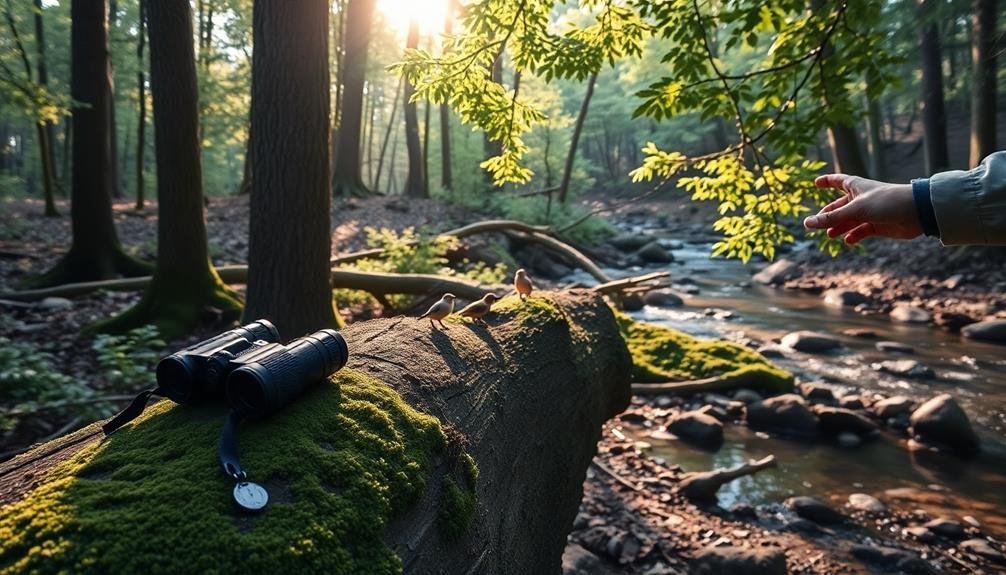To ease anxiety through bird watching, start by choosing peaceful locations like parks or wetlands. Begin with backyard bird watching to build comfort. Learn basic identification skills using field guides or apps. Practice mindful listening to bird calls in quiet spots. Keep a journal to track sightings and experiences. Use binoculars to enhance your focus and observation. Create a bird-friendly environment in your yard with feeders and native plants. Try slow-paced bird photography to capture memorable moments. Plan regular birding excursions to establish a calming routine. Join a local birding group for support and shared knowledge. These tips are just the beginning of your journey into the soothing world of bird watching.
Choose a Peaceful Birding Spot

Find a tranquil location away from bustling crowds and noisy traffic to start your bird-watching journey. Look for parks, nature reserves, or even your own backyard if it's quiet enough. These peaceful spots will help you focus on the birds and their surroundings, allowing your mind to relax and let go of anxiety-inducing thoughts.
Consider visiting local wetlands, forests, or meadows where birds are known to gather. These areas often provide a serene atmosphere and a diverse range of bird species. You'll want to choose a spot with natural features like trees, shrubs, or water sources that attract birds.
Don't forget to check the weather forecast before heading out. A calm, sunny day is ideal for bird watching, but overcast conditions can also be suitable. Avoid windy days, as birds tend to be less active and harder to spot.
If possible, scout potential locations beforehand to guarantee they meet your needs. Look for comfortable seating areas, accessible paths, and minimal human disturbances.
Start With Backyard Bird Watching
For those new to bird watching, your own backyard can serve as an ideal starting point. It's a familiar, comfortable environment where you can observe birds at your own pace without feeling overwhelmed.
Begin by setting up a simple bird feeder or bird bath to attract local species. You'll be surprised at the variety of birds that may visit your yard.
Keep a pair of binoculars and a field guide handy near a window overlooking your yard. This allows you to quickly identify birds when they appear. Start by learning to recognize common backyard birds in your area, such as sparrows, robins, or finches. Pay attention to their distinctive features, colors, and behaviors.
As you become more familiar with backyard birds, try to identify them by their calls and songs. Many bird-watching apps offer audio samples to help you learn.
Keep a journal to record your observations, including the date, time, and species you've spotted. This practice not only improves your bird identification skills but also provides a calming, mindful activity that can help reduce anxiety.
Over time, you'll develop a deeper connection with nature right outside your door.
Learn Basic Bird Identification Skills

As you grow more comfortable observing birds in your backyard, it's time to expand your bird identification skills. Start by focusing on the bird's size, shape, and overall color patterns. Compare them to familiar objects, like "robin-sized" or "sparrow-shaped." Pay attention to distinctive features such as crests, wing bars, or tail shapes.
Invest in a good field guide or download a reputable bird identification app. These resources will help you learn about common species in your area and their distinguishing characteristics. Practice describing birds using specific terminology, like "rufous breast" or "yellow crown."
Listen carefully to bird calls and songs. Each species has unique vocalizations that can aid in identification. Try to memorize a few common calls and match them to the birds you see.
Observe behavior and habitat preferences. Some birds are ground foragers, while others prefer treetops. Noting these habits can narrow down potential species.
Don't get discouraged if you can't identify every bird immediately. Bird watching is a skill that improves with practice. Embrace the learning process and enjoy the calming effects of focusing on nature's details.
Practice Mindful Listening Techniques
Tuning into the natural world through mindful listening can greatly enhance your bird watching experience and reduce anxiety. Start by finding a quiet spot in nature and closing your eyes. Take a few deep breaths to center yourself, then focus on the sounds around you. Listen for different bird calls, rustling leaves, and distant noises.
As you practice, you'll develop the ability to distinguish between various bird songs and calls. Try to identify the direction and distance of each sound. Don't worry if you can't name every bird; the goal is to immerse yourself in the auditory landscape. Pay attention to the rhythm and patterns of the sounds, noting how they change throughout your session.
When your mind wanders, gently bring your focus back to the sounds. This practice not only improves your bird watching skills but also cultivates mindfulness, reducing stress and anxiety.
Over time, you'll find yourself more attuned to the subtle sounds of nature, even in urban environments. This heightened awareness can provide a sense of calm and connection to the natural world, offering a respite from daily worries.
Keep a Bird Watching Journal

Keeping a bird watching journal can greatly enhance your experience and help alleviate anxiety.
You'll want to record species you've spotted and their behaviors, and consider sketching the birds and their habitats to improve your observation skills.
Record Species and Behaviors
Jotting down your bird observations in a journal can transform your bird watching experience. As you record species and behaviors, you'll develop a deeper connection with the birds you encounter.
Start by noting the date, time, and location of each sighting. Then, describe the bird's appearance, including its size, color patterns, and distinctive features. Don't forget to mention any unique behaviors you observe, such as feeding habits, flight patterns, or interactions with other birds.
Use field guides to help identify unfamiliar species, and include sketches or photographs if possible. Pay attention to the bird's vocalizations and try to describe them in your own words. Record environmental factors like weather conditions and habitat type, as these can influence bird behavior and presence.
Over time, you'll notice patterns in bird activity and migration. Your journal will become a valuable resource for tracking seasonal changes and local biodiversity.
It'll also serve as a personal record of your growing expertise and memorable encounters. By focusing on these details, you'll find yourself more fully immersed in the present moment, helping to alleviate anxiety and promote a sense of calm and connection with nature.
Sketch Birds and Habitats
A pencil and sketchbook can be powerful tools for enhancing your bird watching experience and reducing anxiety. By sketching the birds you observe and their habitats, you'll engage in a mindful activity that helps you focus on the present moment.
Don't worry about creating a masterpiece; even simple line drawings can capture the essence of what you see. As you sketch, pay attention to the bird's shape, posture, and distinctive features. Notice how its beak is shaped, the length of its tail, or any unique markings.
Capture the bird's surroundings, too – the trees, shrubs, or water bodies that make up its habitat. This practice will sharpen your observation skills and deepen your connection with nature.
Sketching also serves as a form of meditation, allowing you to let go of racing thoughts and concentrate on the task at hand. It's a great way to slow down and appreciate the beauty around you.
Over time, you'll create a visual journal of your bird watching experiences, which you can look back on to relive those peaceful moments in nature.
Track Seasonal Bird Patterns
Consistency in observation can transform your bird watching experience into a therapeutic journey through the seasons. By tracking seasonal bird patterns, you'll develop a deeper connection with nature and gain a sense of stability amidst life's uncertainties.
Start by keeping a dedicated bird watching journal, noting the date, time, location, and weather conditions for each outing. Record the species you observe, their behaviors, and any notable changes in their appearance or numbers.
Pay attention to migration patterns, nesting habits, and feeding behaviors that shift throughout the year. As you build your journal entries, you'll begin to anticipate the arrival of certain species and notice subtle changes in your local ecosystem.
This practice not only enhances your bird watching skills but also provides a calming routine that can help ease anxiety. By focusing on the cyclical nature of bird activities, you'll gain perspective on your own life's rhythms.
Your journal will become a valuable resource, allowing you to compare observations year after year and deepen your understanding of the natural world around you.
Join a Local Birding Group
Joining a local birding group can be a game-changer for your bird watching experience and anxiety management. These groups offer a wealth of knowledge and support, helping you learn from experienced birders and connect with like-minded individuals.
You'll gain access to insider information about local hotspots, rare bird sightings, and ideal viewing times.
To find a group, check with your local Audubon Society chapter, nature centers, or online birding forums. Many groups offer guided walks, workshops, and field trips, which can help you build confidence in your identification skills and explore new areas.
You'll also have the opportunity to contribute to citizen science projects, such as bird counts and habitat surveys.
Being part of a community can greatly reduce anxiety by providing social support and a sense of belonging. You'll have the chance to share your observations, ask questions, and celebrate your birding achievements with others who share your passion.
Additionally, group outings can help you feel safer when exploring new locations, allowing you to focus on the birds rather than potential safety concerns.
Use Binoculars for Better Focus

To enhance your bird watching experience and reduce anxiety, it's essential to use binoculars effectively.
Start by selecting binoculars with an appropriate magnification power for your needs, typically ranging from 8x to 10x for most birding situations.
You'll also want to practice proper holding techniques, such as keeping your elbows close to your body and using a gentle grip, to minimize shakiness and improve your ability to focus on the birds you're observing.
Choose Appropriate Magnification Power
When you're ready to elevate your bird watching experience, selecting the right magnification power is essential. The ideal magnification depends on your specific needs and the environment you'll be observing birds in.
For beginners, an 8x magnification is often recommended as it provides a good balance between image detail and a wide field of view.
If you're primarily watching birds in open spaces like fields or shorelines, you might prefer a 10x magnification. This higher power allows you to see birds at greater distances, but keep in mind that it may make it harder to locate and follow moving birds.
For dense forests or areas with limited visibility, stick to lower magnifications like 7x or 8x.
Consider binoculars with adjustable magnification, such as 8-12x or 10-22x zoom models. These offer flexibility for various bird watching scenarios.
However, be aware that image quality may decrease at higher magnifications. When choosing, remember that higher magnification also amplifies hand tremors, potentially affecting image stability.
If you have shaky hands, opt for lower magnification or invest in image-stabilized binoculars. Always test different magnifications before purchasing to find what works best for your needs and comfort level.
Practice Proper Holding Technique
Once you've selected the right magnification, mastering the proper holding technique for your binoculars is key to enjoying clear, stable views of birds. Hold the binoculars with both hands, keeping your elbows close to your body for stability. Adjust the interpupillary distance by moving the barrels closer or farther apart until you see a single circular image.
Use the focus wheel to sharpen the image, and if your binoculars have diopter adjustment, fine-tune it for your eyes. When spotting a bird, first locate it with your naked eye, then bring the binoculars up to your eyes without moving your head. This technique, known as "snap-to-view," helps you quickly find and focus on your target.
Here's a quick reference guide for proper binocular holding technique:
| Do | Don't |
|---|---|
| Keep elbows close to body | Hold arms extended |
| Use both hands | Use one hand only |
| Adjust interpupillary distance | Leave barrels misaligned |
| Use focus wheel | Ignore focus adjustment |
| Practice "snap-to-view" technique | Move head to find birds |
Create a Bird-Friendly Environment
How can you attract more feathered friends to your outdoor space? Start by providing the essentials: food, water, and shelter.
Install bird feeders with a variety of seeds to cater to different species. Sunflower seeds, nyjer, and millet are popular choices. Don't forget to clean feeders regularly to prevent disease spread.
Add a birdbath or shallow water feature for drinking and bathing. Keep it clean and refill it daily.
Plant native trees, shrubs, and flowers that produce berries, seeds, or nectar. These won't only attract birds but also provide natural food sources and nesting materials.
Create cover by adding brush piles or dense shrubs where birds can hide from predators. Install birdhouses appropriate for local species, ensuring they're placed at the right height and facing away from prevailing winds.
Avoid using pesticides in your yard, as they can harm birds and reduce insect populations that many birds rely on for food. Instead, embrace natural pest control methods.
Embrace Slow-Paced Bird Photography

As you explore bird watching for anxiety relief, consider embracing slow-paced bird photography. This mindful approach allows you to fully immerse yourself in the present moment while capturing nature's beauty.
Start by investing in a camera with a good zoom lens, enabling you to photograph birds from a distance without disturbing them.
Choose a comfortable spot and settle in quietly. Patience is key; allow yourself to relax and observe your surroundings. As you wait for birds to appear, focus on your breathing and the natural sounds around you.
When a bird does arrive, take your time framing the shot. Don't rush to capture every movement; instead, savor the experience of watching the bird's behavior.
Experiment with different angles and compositions, but remember that the process is more important than the result. Use this time to practice mindfulness, letting go of intrusive thoughts and concentrating on the task at hand.
After your session, review your photos calmly, appreciating the details you've captured. This slow, deliberate approach to bird photography can greatly reduce anxiety while enhancing your connection with nature.
Plan Regular Birding Excursions
Planning regular birding excursions can considerably boost your anxiety-reducing efforts. By setting aside dedicated time for bird watching, you're creating a structured approach to managing stress. Aim to schedule weekly or bi-weekly outings, varying the locations to keep things interesting. You'll find that anticipating these trips can provide a sense of purpose and excitement, helping to counteract anxious thoughts.
When planning your excursions, consider the following factors:
| Season | Best Time | Ideal Locations |
|---|---|---|
| Spring | Early morning | Parks, wetlands |
| Summer | Dawn or dusk | Forests, meadows |
| Fall | Mid-morning | Coastal areas, fields |
Choose locations that offer a mix of environments to increase your chances of spotting diverse bird species. Don't forget to pack essentials like binoculars, a field guide, and water. As you become more familiar with local birding spots, you'll develop a comforting routine that can serve as a reliable anxiety management tool. Remember, consistency is key – regular outings will help you build a sustainable practice that supports your mental well-being over time.
Frequently Asked Questions
How Can Bird Watching Help With Specific Anxiety Disorders?
Bird watching can help with specific anxiety disorders by giving you a calming focus. You'll practice mindfulness, engage in nature, and distract from anxious thoughts. It's a gentle, non-threatening activity that encourages you to slow down and observe.
Are There Any Potential Risks or Dangers Associated With Bird Watching?
While generally safe, you should be aware of potential risks like tick bites, poison ivy, or accidents in rugged terrain. Always carry proper gear, stay alert to your surroundings, and don't trespass on private property when bird watching.
Can Bird Watching Be Combined With Other Anxiety-Reducing Techniques?
Yes, you can easily combine bird watching with other anxiety-reducing techniques. Try pairing it with deep breathing, mindfulness meditation, or gentle exercise like walking. You'll enhance the calming effects and create a more holistic approach to managing your anxiety.
What Time of Day Is Best for Bird Watching to Reduce Anxiety?
You'll find early morning is ideal for bird watching. It's when birds are most active and vocal. However, don't limit yourself. Any time you can observe birds can be calming and reduce anxiety throughout the day.
How Long Should a Bird Watching Session Last for Optimal Anxiety Relief?
You'll find ideal anxiety relief from a 30-60 minute bird watching session. However, don't stress about timing. Listen to your body and end when you feel calm. Even short 10-minute sessions can be beneficial for quick stress relief.
In Summary
You've got the tools to make bird watching your anxiety-busting hobby. Remember, it's not about spotting the rarest species; it's about connecting with nature and finding peace. Whether you're in your backyard or a far-off forest, take time to breathe, observe, and appreciate the winged wonders around you. With practice, you'll find that bird watching becomes a natural remedy for stress. So grab your binoculars and let the birds guide you to tranquility.





Leave a Reply